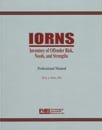
Inventory of Offender Risk, Needs, and Strengths iorns
For: Identify static, dynamic, and protective factors related to offender risk, treatment need, and management in ages 18 years and older
Reading Level: Adult - Elder Adult
Format: Paper-and-Pencil
Length: 15-20 minutes
Scoring: Hand Scored
Printed Kits
Click to browse products
Printed Forms & Handscoring Materials
Test forms, response booklets and scoring reference manuals.
IORNS Introductory Kit
IORNS Professional Manual
IORNS Response Forms (25)
IORNS Scoring Summary/Profile Forms (25)
Author
Holly A. Miller, PhD
Description
The IORNS is a 130-item self-report measure that assesses static risk, dynamic risk/need, and protective strength factors as they relate to recidivism, treatment need and management.
The IORNS provides index and scale scores that are internally consistent and stable over time, in addition to content subscales that aid in interpretive specificity.
The IORNS indexes, scales, and subscales demonstrate good convergent and discriminant validity with self-report, interview, and objective criminal history measures of anti-social behaviour, psychopathy, personality pathology, substance use, depression, and anxiety among numerous male and female offender samples.
The IORNS consists of the four IORNS indexes, eight scales, 14 subscales, and two validity scales. T scores, percentiles, confidence intervals and qualitative classifications (i.e. low, average, high, very high) are provided for the normative samples. Given low or high endorsement of certain items, percentiles and percentile classifications are recommended for interpretation.
Special Features
Is the only instrument that assesses all three types of factors (static, dynamic, and protective factors) important to recidivism by providing a more comprehensive risk assessment than is currently available through concomitant assessment.
May be group administered at offender intake, thereby reducing clinician burden.
May be administered and scored by persons who do not have training in forensic or clinical psychology or psychiatry, with supervision and interpretation by a licensed or certified professional.
Written at a 3rd-grade reading level.
Standardised and validated with offenders (men aged 18-75 years and women aged 18-60 years). Offender samples included incarcerated and probated general and sexual offenders.
Community adult/college normative sample also provided (men and women aged 18-75 years). The community adult/college normative group approximates U.S. Census proportions (U.S. Bureau of the Census, 2003) for race/ethnicity and educational status.
The validity of the IORNS is based on multiple sources of evidence, including content validity, convergent and discriminant validity, and internal structure of the measure via factor analysis.
Constructs of interest were chosen based on their relationship between recidivism, desistance, or protection and criminal behaviour.
The IORNS demonstrated significant correlations with self-reported criminal history variables, including number of nonviolent and violent crimes and number of times in jail/prison among male and female offenders. The IORNS also was significantly related to numerous self-reported criminal, familial, and substance use history variables (e.g. past physical and sexual abuse) among female offenders.
Evidence for construct validity of the IORNS was further demonstrated through significant correlations with the following measures within various offender groups:
– Level of Service Inventory-Revised (LSI-R)
– Sexual Offender Needs Assessment Rating Scale (SONAR)
– Personality Assessment Inventory (PAI)
– Psychopathy Checklist-Revised (PCL-R)
– Psychopathic Personality Inventory-Revised (PPI-R)
– Levenson’s Self-Report Psychopathy Scale (LSRP)
– Self-Report Psychopathy Scale-II (SRP-II)
– Substance Abuse Subtle Screening Inventory-3 (SASSI-3)
– Center for Epidemiologic Studies Depression Scale (CES-D)
– State-Trait Anxiety Inventory (STAI)
– Factor analysis supports separate Dynamic Need and Protective Strength factors
NB: Prices are in Australian dollars inclusive of GST. NZ customers need to log in to view ex-GST prices.



